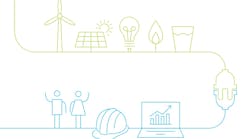Like death and taxes, the utility bill is a certainty for all. Yet, there is a surprising lack of digital payment options to make it easier for customers, especially considering that these transactions represent the primary way that a customer interacts with their local utility — it essentially defines their customer experience.
It’s not that utility providers are standing still in this regard. More than half have the capability to process all monthly bill payments digitally, but only 12% do so. Some of the concerns that hold them back include acquiring the proper technology, uncertainty about whether employees have the skills necessary to complete the transition to digital payments, and, of course, resource limitations.
But with the recent economic downturn and high inflation burdening consumers with greater debt, providing a better payment experience has become more critical than ever, and power suppliers are pressured to help ease this burden. According to research from FinMasters, over 95% of Americans, regardless of income level, are most worried about the rising costs of gas, food, utilities, and housing. Now is the right time to make sure customers have some flexibility in keeping the lights on (literally).
Utilities and customers ultimately want the same thing: to keep the electricity flowing and for customer accounts to stay up-to-date. While it might seem obvious to offer better and more flexible payment experiences, clearly there are some perceived challenges that can be overcome through the benefits of digital payments for both utilities and their customers.
Challenge 1: A Lack of Resources and Expertise
Electric utilities have limited staff and tight budgets, so their resources are primarily aimed at delivering reliable service to customers. In addition, they typically don’t have the expertise to manage the digital payments experience. The hesitancy to jump into something ill-prepared is understandable, as doing so could cause more problems than solutions.
The good news is that payments expertise and technology can be outsourced. A modern service provider can offer more than just processing payment transactions, and can deliver value-added services like multi-language call centers, payment alert reminders, and interactive voice response (IVR) payment options, so utilities don’t need to manage the process or get mired in technology. They can continue focusing on their core competencies instead.
Challenge 2: Customer Adoption
Despite the simplicity and efficiency of electronic payments, onboarding customers can be challenging. There are plenty of individuals still clinging to writing paper checks, sending them in the mail, and waiting for the payment to be processed. It isn’t just the older generations, as one might think. A recent survey found that 37% of millennials wrote a check in June 2022. Not only is this inefficient for customers but it’s more expensive for the utility provider as well. Check processing slows the payment cycle and can cost six times more than digital payments when considering operational expenses. Checks were also the payment method most impacted by fraud activity in 2021, despite a common misperception that it’s safer than digital payments. Additionally, paper checks can create reporting inconsistencies due to manual data entry on inbound and outbound payments.
Utilities investing in digital payments naturally want to ensure customers take advantage of the services but may not have the bandwidth to push for adoption. Some payment service providers (PSPs) or independent software vendors (ISVs) that provide payment processing will offer white-label marketing resources geared towards increasing adoption of digital payment systems. Delivering proven messaging about the benefits of standard or automated digital payments can help push customers over the hump. There are also features such as text-to-pay and late notifications that drive digital payments. For every customer that opts-in, utilities save money and time with every transaction.
Challenge 3: Providing a Better Customer Experience with Flexible Payment Options
Many utilities are already offering customers cost-saving measures to ease the burden, such as a credit towards the bill in exchange for limiting air conditioning usage during high-usage time periods or email tips on how to lower electricity usage. This same effort should be applied to help them make payments and avoid a collection conversation. Customers want options, not limitations. They appreciate convenience and want to make their own payment decisions, whether that be mailing a check, paying by phone (e.g., via interactive voice response), digital online payments, pay by text, pay by email, etc. Additionally, offering flexibility in payment plans can avoid high interest rates and the threat of service termination if they miss a payment. It’s a win-win where customers benefit from frictionless payment experiences that work for them, while utilities streamline the process, remove manual processes, and lower transaction costs.
Electric utility providers and their customers are working towards a common goal to make sure the service stays on and payments are made on time. By understanding the benefits of digital payments, utility providers can hopefully have less of tough conversations and keep the revenue flowing in this difficult economic climate.
Michele Shepard has more than 20 years of experience building world class sales organizations. As Chief Commercial Officer of Paya, she focuses on developing and executing forward-thinking customer engagement strategies across sales, marketing, and customer success. Michele’s previous experience includes leading high-growth sales and business development teams as well as implementing successful go-to-market strategies at high growth vertical software companies Insurity and Vertafore. Michele also served as a senior sales leader at Gartner, focusing on tailoring sales to targeted vertical end markets.


